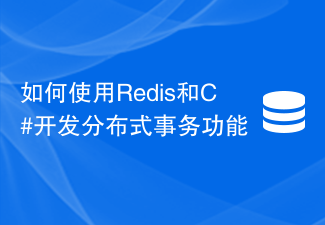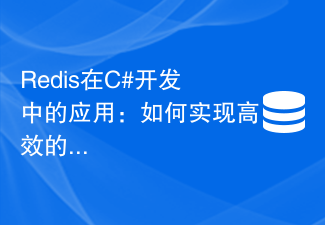 Backend Development
Backend Development C#.Net Tutorial
C#.Net Tutorial The latest summary of matters related to the understanding and use of pointers in C language
The latest summary of matters related to the understanding and use of pointers in C languageDefinition: A pointer is a variable whose value is the address of another variable. The address represents the location in memory. What needs to be remembered is that the array variable itself is a pointer.
Type of address
Addresses have types. Doesn’t it feel strange? Doesn’t a pointer represent an address? Does an address also have a type? Look at an example:
int *ip; /* 一个整型的指针 */ double *dp; /* 一个 double 型的指针 */ float *fp; /* 一个浮点型的指针 */ char *ch; /* 一个字符型的指针 */
In fact, a pointer is always just a hexadecimal number representing an address. The so-called type refers to the type of the variable pointed by the pointer.
Using pointers
How to define a pointer, you should know from the previous example, then how to print the hexadecimal address and or the data pointed to by the pointer:
//通过&运算符获取了i的地址并保存到intP中去
int *intP; = &i;
printf("intP存储的地址为:%p,存储的地址指向的数据为:%d\n", intP, *intP);Pointers can perform operations: , --, , -
In addition, pointers can also be compared using relational operators, such as ==,
int intArr[] = {1, 2, 3, 4, 5, 6, 7, 8, 9, 10};
//先定义一个指针执行数组第一个元素
int *intArrP = &intArr[0];
printf("此时intArrP存储的地址为:%p,数据为:%d\n", intArrP, *intArrP);
//自增一下看看结果(每增加一次,它都将指向下一个整数位置)
intArrP++;
printf("自增以后intArrP存储的地址为:%p,数据为:%d\n", intArrP, *intArrP);Pointers You can also point to pointers
int data = 5201314;
int *p1 = &data;
int **p2 = &p1;
printf("%d\n", data); //都是5201314
printf("%d\n", *p1);
printf("%d\n", **p2);Structures and pointers
The use of pointers in structures is a little special, mainly because of the particularity of the structure itself, and you want to use a value in the structure , generally divided into two situations: the structure itself and the pointer pointing to the structure. See the following example for details:
struct Node
{
int val;
};
//先建立一个结构体数据
struct Node node;
node.val = 1;
struct Node *nodeP; //创建一个指向刚刚的结构体的指针
nodeP = &node;
printf("%d\n", nodeP->val);//指向结构体的指针用->
printf("%d\n", node.val);//结构体自身用.Related articles:
The above is the detailed content of The latest summary of matters related to the understanding and use of pointers in C language. For more information, please follow other related articles on the PHP Chinese website!
 如何使用C#编写时间序列预测算法Sep 19, 2023 pm 02:33 PM
如何使用C#编写时间序列预测算法Sep 19, 2023 pm 02:33 PM如何使用C#编写时间序列预测算法时间序列预测是一种通过分析过去的数据来预测未来数据趋势的方法。它在很多领域,如金融、销售和天气预报中有广泛的应用。在本文中,我们将介绍如何使用C#编写时间序列预测算法,并附上具体的代码示例。数据准备在进行时间序列预测之前,首先需要准备好数据。一般来说,时间序列数据应该具有足够的长度,并且是按照时间顺序排列的。你可以从数据库或者
 如何使用Redis和C#开发分布式事务功能Sep 21, 2023 pm 02:55 PM
如何使用Redis和C#开发分布式事务功能Sep 21, 2023 pm 02:55 PM如何使用Redis和C#开发分布式事务功能引言分布式系统的开发中,事务处理是一项非常重要的功能。事务处理能够保证在分布式系统中的一系列操作要么全部成功,要么全部回滚。Redis是一种高性能的键值存储数据库,而C#是一种广泛应用于开发分布式系统的编程语言。本文将介绍如何使用Redis和C#来实现分布式事务功能,并提供具体代码示例。I.Redis事务Redis
 如何实现C#中的人脸识别算法Sep 19, 2023 am 08:57 AM
如何实现C#中的人脸识别算法Sep 19, 2023 am 08:57 AM如何实现C#中的人脸识别算法人脸识别算法是计算机视觉领域中的一个重要研究方向,它可以用于识别和验证人脸,广泛应用于安全监控、人脸支付、人脸解锁等领域。在本文中,我们将介绍如何使用C#来实现人脸识别算法,并提供具体的代码示例。实现人脸识别算法的第一步是获取图像数据。在C#中,我们可以使用EmguCV库(OpenCV的C#封装)来处理图像。首先,我们需要在项目
 如何使用C#编写动态规划算法Sep 20, 2023 pm 04:03 PM
如何使用C#编写动态规划算法Sep 20, 2023 pm 04:03 PM如何使用C#编写动态规划算法摘要:动态规划是求解最优化问题的一种常用算法,适用于多种场景。本文将介绍如何使用C#编写动态规划算法,并提供具体的代码示例。一、什么是动态规划算法动态规划(DynamicProgramming,简称DP)是一种用来求解具有重叠子问题和最优子结构性质的问题的算法思想。动态规划将问题分解成若干个子问题来求解,通过记录每个子问题的解,
 使用golang中的json.MarshalIndent函数将结构体转换为格式化的JSON字符串Nov 18, 2023 pm 01:59 PM
使用golang中的json.MarshalIndent函数将结构体转换为格式化的JSON字符串Nov 18, 2023 pm 01:59 PM使用golang中的json.MarshalIndent函数将结构体转换为格式化的JSON字符串在使用Golang编写程序时,我们经常需要将结构体转换为JSON字符串,在这个过程中,json.MarshalIndent函数可以帮助我们实现格式化的输出。下面我们将详细介绍如何使用这个函数,并提供具体的代码示例。首先,让我们创建一个包含一些数据的结构体。以下是示
 Redis在C#开发中的应用:如何实现高效的缓存更新Jul 30, 2023 am 09:46 AM
Redis在C#开发中的应用:如何实现高效的缓存更新Jul 30, 2023 am 09:46 AMRedis在C#开发中的应用:如何实现高效的缓存更新引言:在Web开发中,缓存是提高系统性能的常用手段之一。而Redis作为一款高性能的Key-Value存储系统,能够提供快速的缓存操作,为我们的应用带来了不少便利。本文将介绍如何在C#开发中使用Redis,实现高效的缓存更新。Redis的安装与配置在开始之前,我们需要先安装Redis并进行相应的配置。你可以
 如何实现C#中的图像压缩算法Sep 19, 2023 pm 02:12 PM
如何实现C#中的图像压缩算法Sep 19, 2023 pm 02:12 PM如何实现C#中的图像压缩算法摘要:图像压缩是图像处理领域中的一个重要研究方向,本文将介绍在C#中实现图像压缩的算法,并给出相应的代码示例。引言:随着数字图像的广泛应用,图像压缩成为了图像处理中的重要环节。压缩能够减小存储空间和传输带宽,并能提高图像处理的效率。在C#语言中,我们可以通过使用各种图像压缩算法来实现对图像的压缩。本文将介绍两种常见的图像压缩算法:
 如何实现C#中的遗传算法Sep 19, 2023 pm 01:07 PM
如何实现C#中的遗传算法Sep 19, 2023 pm 01:07 PM如何在C#中实现遗传算法引言:遗传算法是一种模拟自然选择和基因遗传机制的优化算法,其主要思想是通过模拟生物进化的过程来搜索最优解。在计算机科学领域,遗传算法被广泛应用于优化问题的解决,例如机器学习、参数优化、组合优化等。本文将介绍如何在C#中实现遗传算法,并提供具体的代码示例。一、遗传算法的基本原理遗传算法通过使用编码表示解空间中的候选解,并利用选择、交叉和


Hot AI Tools

Undresser.AI Undress
AI-powered app for creating realistic nude photos

AI Clothes Remover
Online AI tool for removing clothes from photos.

Undress AI Tool
Undress images for free

Clothoff.io
AI clothes remover

AI Hentai Generator
Generate AI Hentai for free.

Hot Article

Hot Tools

mPDF
mPDF is a PHP library that can generate PDF files from UTF-8 encoded HTML. The original author, Ian Back, wrote mPDF to output PDF files "on the fly" from his website and handle different languages. It is slower than original scripts like HTML2FPDF and produces larger files when using Unicode fonts, but supports CSS styles etc. and has a lot of enhancements. Supports almost all languages, including RTL (Arabic and Hebrew) and CJK (Chinese, Japanese and Korean). Supports nested block-level elements (such as P, DIV),

MinGW - Minimalist GNU for Windows
This project is in the process of being migrated to osdn.net/projects/mingw, you can continue to follow us there. MinGW: A native Windows port of the GNU Compiler Collection (GCC), freely distributable import libraries and header files for building native Windows applications; includes extensions to the MSVC runtime to support C99 functionality. All MinGW software can run on 64-bit Windows platforms.

SublimeText3 English version
Recommended: Win version, supports code prompts!

SecLists
SecLists is the ultimate security tester's companion. It is a collection of various types of lists that are frequently used during security assessments, all in one place. SecLists helps make security testing more efficient and productive by conveniently providing all the lists a security tester might need. List types include usernames, passwords, URLs, fuzzing payloads, sensitive data patterns, web shells, and more. The tester can simply pull this repository onto a new test machine and he will have access to every type of list he needs.

SublimeText3 Chinese version
Chinese version, very easy to use






